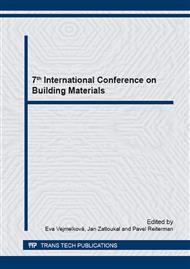[1]
Q. Yuan, C. Shi, G. De Schutter, K Audenaert, D. Deng, Chloride binding of cement-based materials subjected to external chloride environment – A review, Constr. Build. Mater. 23 (2009) 1-13.
DOI: 10.1016/j.conbuildmat.2008.02.004
Google Scholar
[2]
Z. Pavlík, M. Jiřičková, R. Černý, H. Sobczuk, Z. Suchorab, Determination of moisture diffusivity using the time domain reflectometry (TDR) method, J. Build. Phys. 30 (2006) 59-70.
DOI: 10.1177/1744259106064356
Google Scholar
[3]
Z. Pavlík, M. Pavlíková, M. Keppert, R. Černý, Salt transport and storange parametres of renovation plasters and their possible effects on restored buildings walls, Constr. Build. Mater. 25 (2011) 1205-1212.
DOI: 10.1016/j.conbuildmat.2010.09.034
Google Scholar
[4]
M. Pavlíková, Z. Pavlík, L. Fiala, H. Benešová, J. Mihulka, R. Černý, Effect of slag on chloride transport and storage properties of HPC, 6th International Conference on Concrete under Severe Conditions-Environment and Loading (2010) 1497-1504.
DOI: 10.1201/b10552-205
Google Scholar
[5]
A. Neville, Chloride attack of reinforced concrete: an overview, Mater. Struct. 28 (1995) 63-70.
Google Scholar
[6]
P. Bénard, C. Cau Dit Coumes, S. Garrault, A. Nonat, S. Courtois, Dimensional stability under wet curing of mortars containing high amounts of nitrates and phosphates, Cem. Concr. Res. 38 (2008) 1181-1189.
DOI: 10.1016/j.cemconres.2008.04.001
Google Scholar
[7]
K. Daugherty, The interaction of calcium nitrate and class C fly ash during hydration, Cem. Concr. Res. 26 (1996) 1131-1143.
DOI: 10.1016/0008-8846(96)00074-9
Google Scholar
[8]
Z. Pavlík, M. Keppert, M. Pavlíková, P. Volfová, R. Černý, Application of MSWI bottom ash as alternative aggregate in cement mortar, WIT Trans. Ecol. Environ. 148 (2012) 335-342.
DOI: 10.2495/rav110311
Google Scholar
[9]
M. Keppert, P. Reiterman, Z. Pavlík, M. Pavlíková, M. Jerman, R. Černý, Municipal solid waste incineration ashes and their potential for partial replacement of Portland cement and fine aggregates in concrete, Cem. Wapno Beton 15 (2010) 187-193.
Google Scholar
[10]
Z. Pavlík, M. Keppert, M. Pavlíková, A. Trník, R. Černý, High Temperature Testing of Cement Mortar Containing MSWI Bottom Ash, Appl. Mech. Mater. 377 (2013) 55-59.
DOI: 10.4028/www.scientific.net/amm.377.55
Google Scholar


